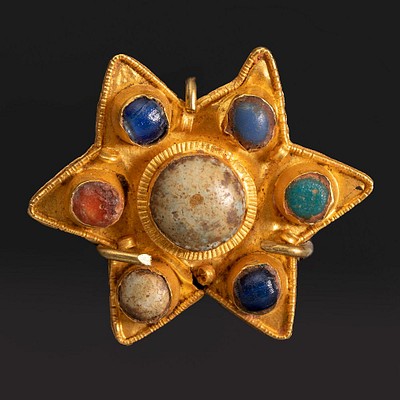Chasuble; Cordoba, XIX century. Silk with print, and embroidered with metallic thread. Linen lining.
Lot 92
About Seller
Setdart Auction House
Carrer Aragó 346
Barcelona
Spain
Setdart Subastas was born in 2004 and is currently the first online art auction in Spain with solidity, prestige and reliability guaranteed by our more than 60,000 users. Setdart has a young, dynamic and enterprising team ready to successfully manage the purchase and sale of art works through custom...Read more
Categories
Estimate:
EUR€500 - EUR€600
$520.83 - $625
Absentee vs Live bid
Two ways to bid:
- Leave a max absentee bid and the platform will bid on your behalf up to your maximum bid during the live auction.
- Bid live during the auction and your bids will be submitted real-time to the auctioneer.
Bid Increments
| Price | Bid Increment |
|---|---|
| EUR€0 | EUR€10 |
| EUR€200 | EUR€25 |
| EUR€500 | EUR€50 |
| EUR€1,000 | EUR€100 |
| EUR€3,000 | EUR€200 |
| EUR€5,000 | EUR€500 |
| EUR€10,000 | EUR€1,000 |
| EUR€20,000 | EUR€2,000 |
| EUR€50,000 | EUR€5,000 |
About Auction
By Setdart Auction House
Dec 21, 2021
Set Reminder
2021-12-21 07:30:00
2021-12-21 07:30:00
America/New_York
Bidsquare
Bidsquare : Córdoba: 2,000 Years of Art
https://www.bidsquare.com/auctions/setdart-auction-house/c-rdoba-2-000-years-of-art-8049
Setdart Auction House sofia@setdart.com
Setdart Auction House sofia@setdart.com
- Lot Description
Chasuble; Cordoba, XIX century. Silk with print, and embroidered with metallic thread. Linen lining. Measurements: 112 x 60 cm. Chasuble decorated with a central band embroidered with golden metal thread. On the inside of the embroidered band, the chasuble has floral motifs on the front and back. The chasuble, a special priestly vestment for mass, was originally a long sleeveless cloak with an opening in the center for the head to pass through. It was worn in ancient times by people of the lower orders, but gradually made its way into other circles and thus reached the monks and clergy. The historical development of the alb elevated this object, at the beginning of the Middle Ages, to the rank of an exclusively liturgical vestment for the priesthood, after having been worn for a time in other clerical circles. This dedication to liturgical purposes necessitated some modifications; for example, the mantle was shortened, being provided with cords on the sides. During and after the Renaissance the chasuble was deformed into the present rigid contrabass shape, whereby both parts, loosely loose, fall over the chest and back. In the early Middle Ages wool was almost exclusively its material. The influence of Gothic art made the use of silk more frequent, which was the norm in the 15th century. At the beginning the color was white, but gradually a variety of colors became fixed, depending on the time of year and festivities. Ornamentation was limited in ancient times to a band that bordered the opening of the head and went down over the chest and back. Additions were branched crosses, decorated leaves, figures and scenes, all expensively decorated in gold, silver and jewels. The chasuble now in common use is distinguished by a Latin cross on both sides. Common fabrics, linen, cotton or especially coarse wool, are forbidden. The symbolism is charity.
- Shipping Info
-
In-house shipping available. Please inquire at admin@setdart.com.
-
- Buyer's Premium



 EUR
EUR CAD
CAD AUD
AUD GBP
GBP MXN
MXN HKD
HKD CNY
CNY MYR
MYR SEK
SEK SGD
SGD CHF
CHF THB
THB















